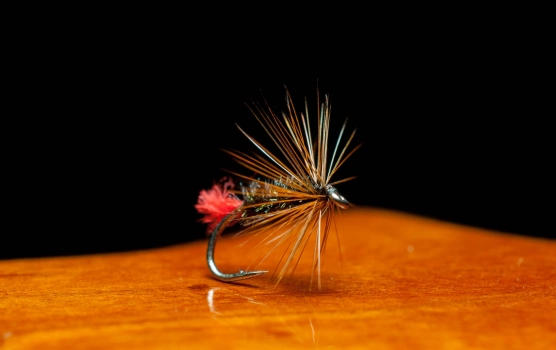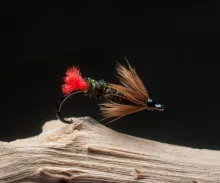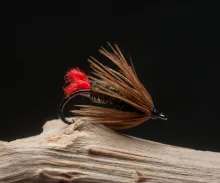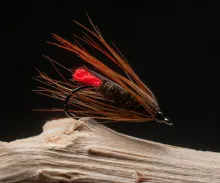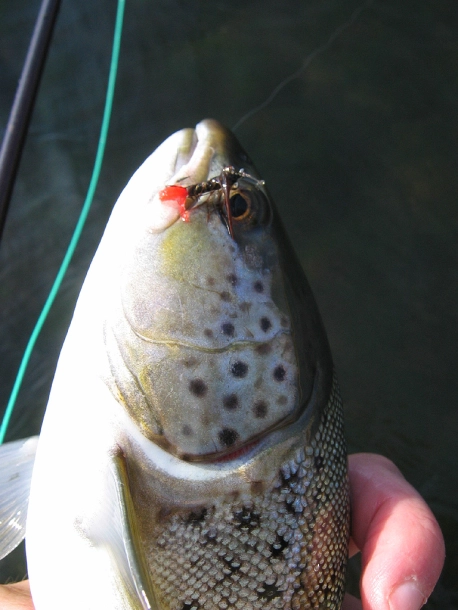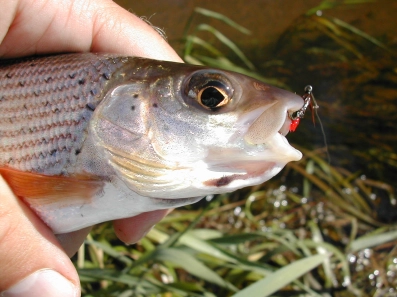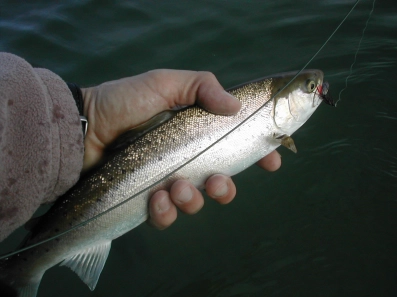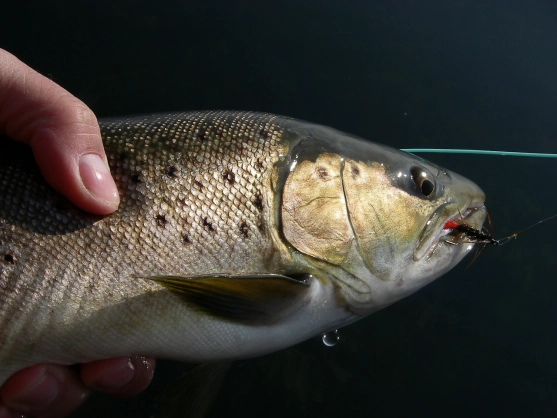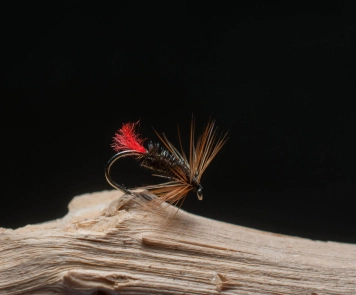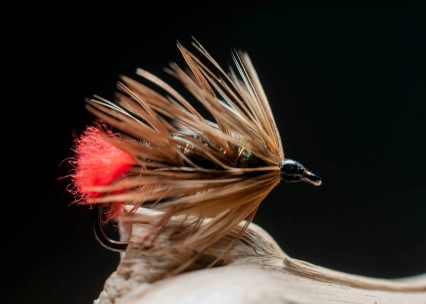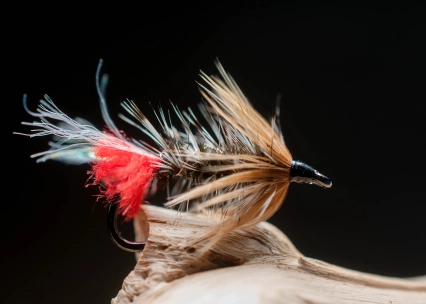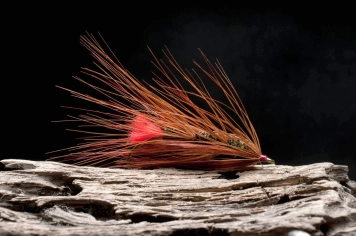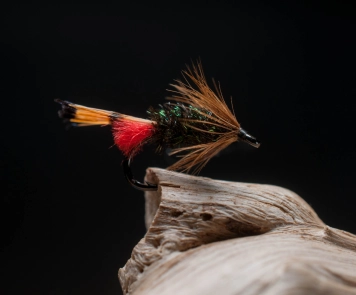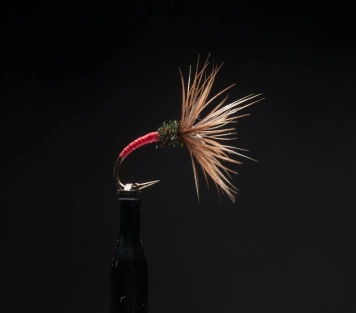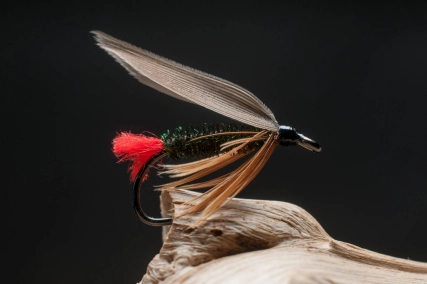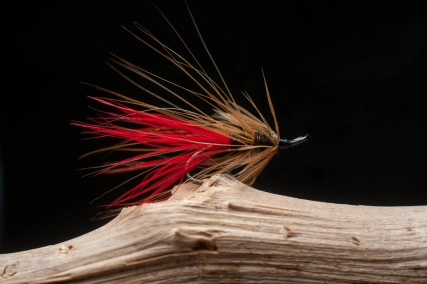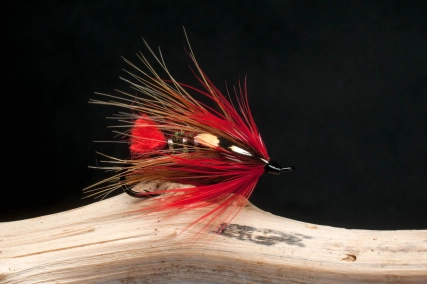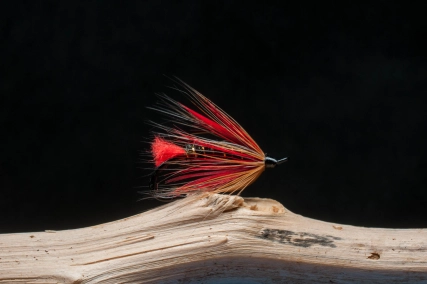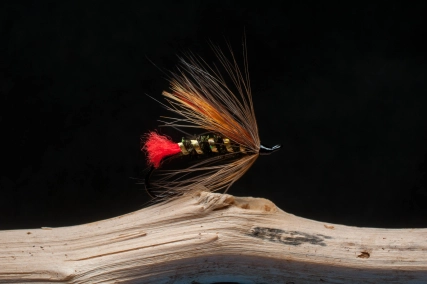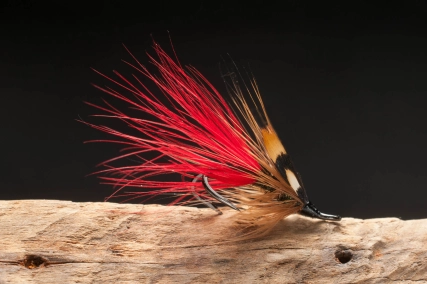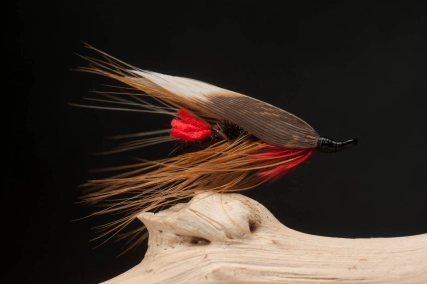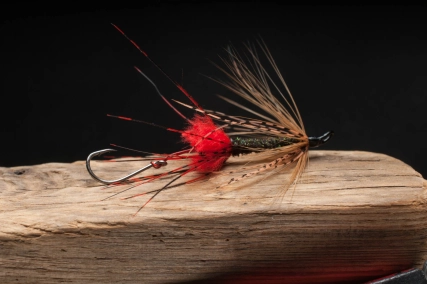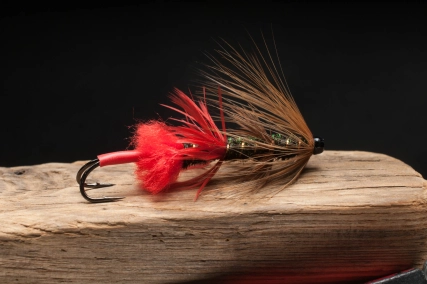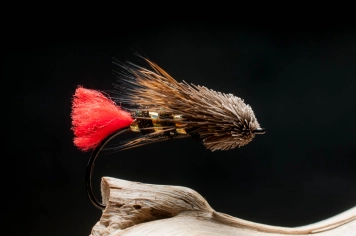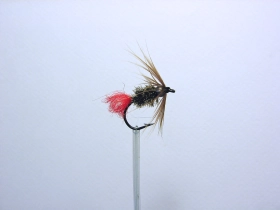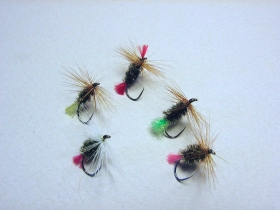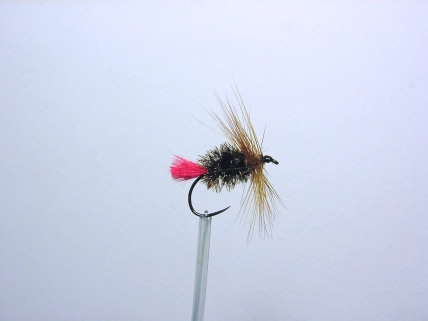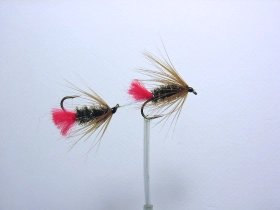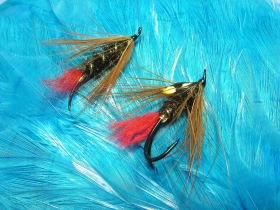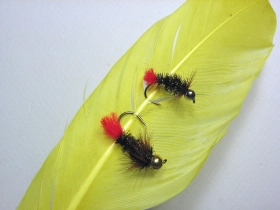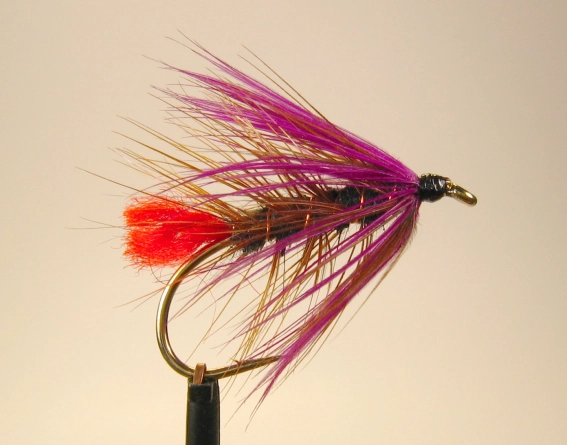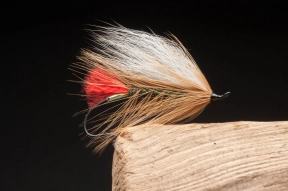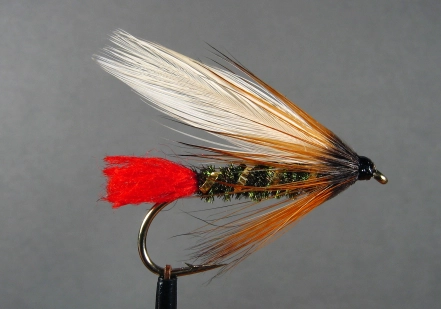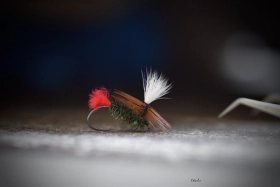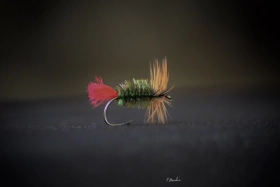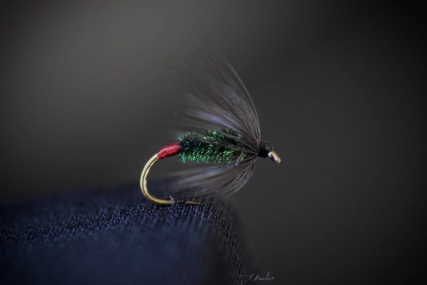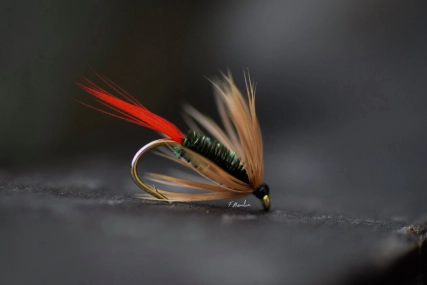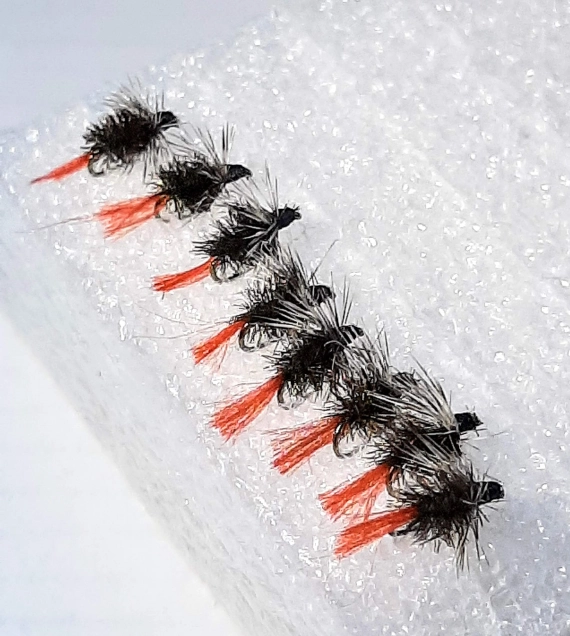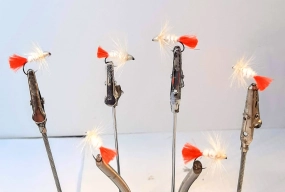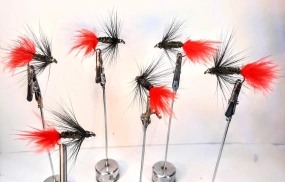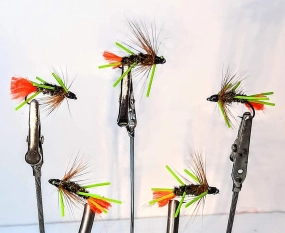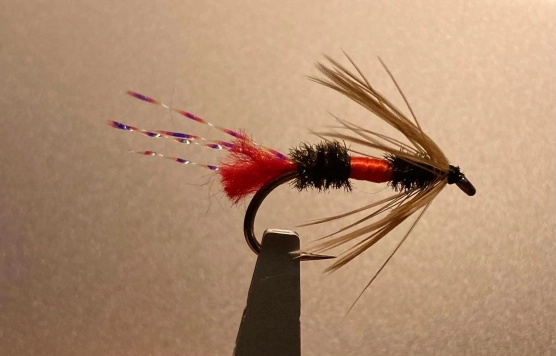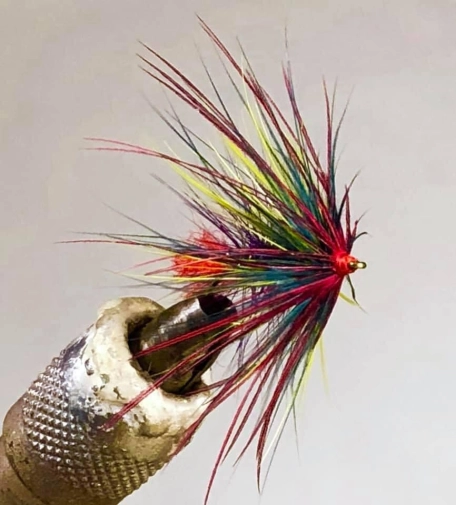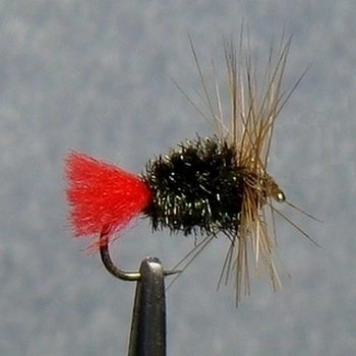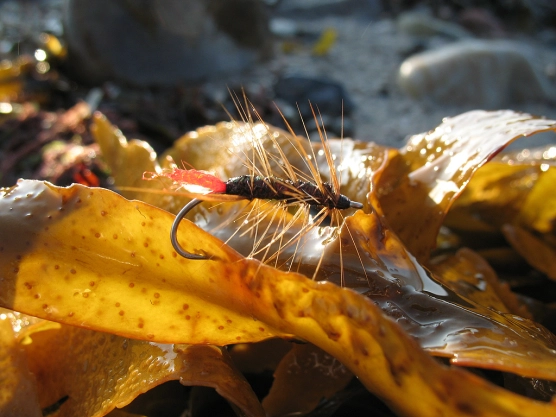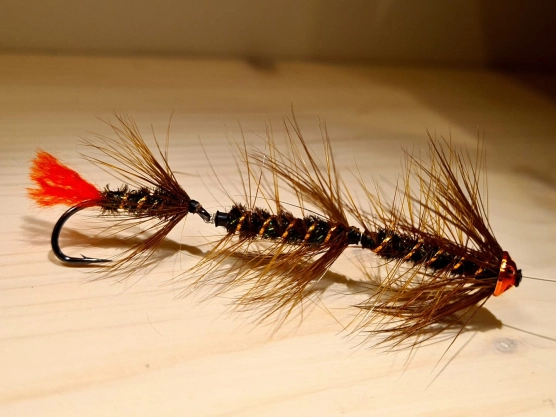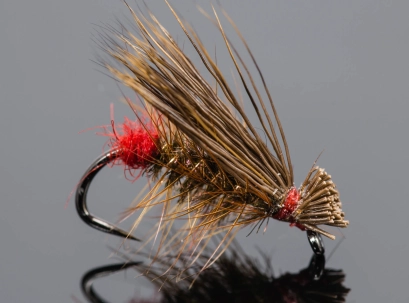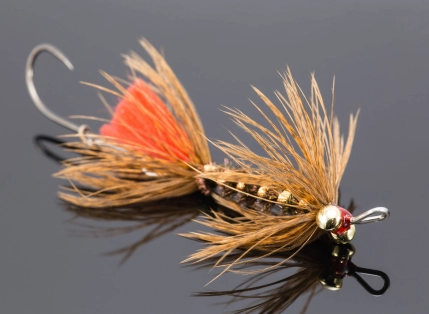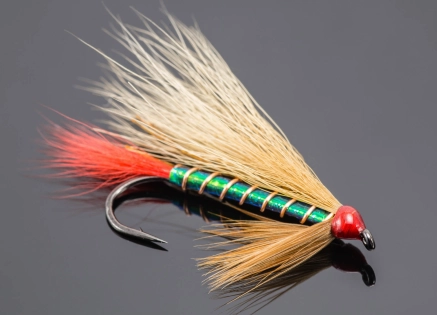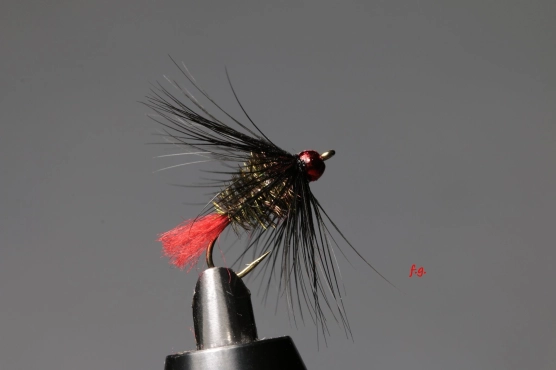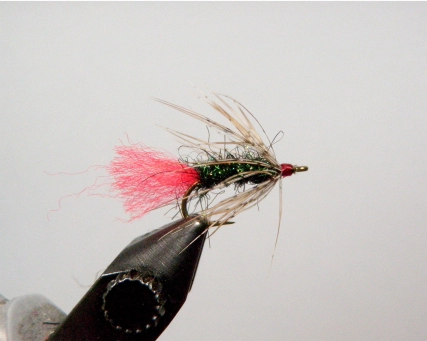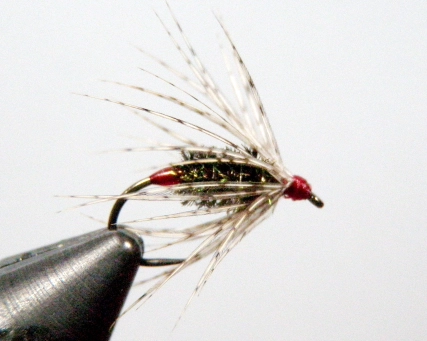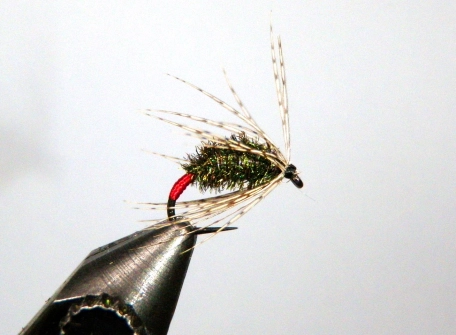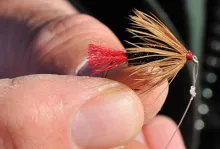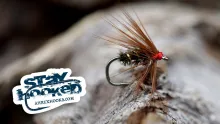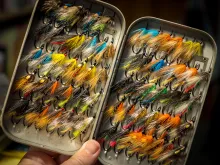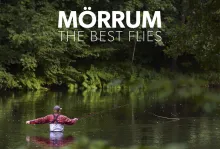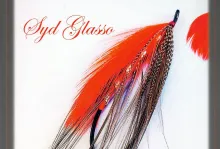I always loved the Red Tag. I have tied and fished this fly a thousand times, but tend to basically do it the same way every time. Not so anymore!
The Red Tag is up there with some of the really great and classic fly patterns. It even has its own entry in Wikipedia – not a long one, but still. It’s only a few flies that have attained the “Wikipedia-glory”!
The Red Tag is widespread and well known, it’s popular and it has been tied, fished and loved for more than a century, so the spot is well deserved.
A long history
It’s a fly that traces back to 1850 where British Martyn Flynn from Worcestershire tied it as the Worcestershire Gem or the Worcestershire Wonder. Perrault also refers to it as the Treacle Parkin in his wonderful pattern book, but although the Treacle Parkin is very much like the Red Tag, it has a yellow or green tag. It can, like the Red Tag, be tied as a dry or a spider. Yorkshire Parkin, by the way, is a ginger cake, and treacle is a syrup – used in said cake and other dishes, but that’s of course a whole other story.
The Red Tag has other names, and as a US friend, Deryn LaCombe, writes: “It works fantastic on brook and rainbow trout this side of the Atlantic, but generally it's just referred to as a Brown Hackle Peacock”.
How it wound up being called the Red Tag is probably no big wonder since its prime hallmark is indeed a red tag – which by the way technically is a red tail on most incarnations of the fly.
It was originally tied as a dry fly and was meant to catch grayling, but has developed into a wet fly in the soft hackle style as well as a more bugger-like fly, often referred to as the Red Tag Palmer because of the palmer hackle – a hackle in the full length of the body.
|
|
|
|
Another odyssey
I use an adapted version of the pattern for my coastal sea trout fishing in the Baltic, and have done so for decades. I have always liked the fly, and it has produced numerous fish for me.
I tied a few the other night to fill my flybox, and was as always pleased with the simplicity and good looks of the fly. And of course also pleased with the fact that I know this is a killer fly, which will help me catch sea trout in the coming season, especially late in the season where it’s one of my go-to flies for the picky autumn fish.
As it often happens when I’m at the vise, I started experimenting. My tying sessions tend to go in two directions: either I tie the same pattern repeatedly like a machine to fill a box, or I digress and start digging out new materials and change the pattern I’m tying.
In this case I had taken a hackle slightly too short for the hook size, and I dug out a longer one for the next fly. Pleased with the result, I thought: “How about one slightly longer?”
I couldn’t find a hen hackle that I liked, so I looked in my golden pheasant stash and found a short fibered and dull GP body feather, which suited the fly well. Soon I could feel where this was going: I was on my way on a new odyssey, revisiting the Red Tag, tying it the old way and taking it to new places – if not to new heights.
The keys
Like the The March Brown has its key components: hare’s wool dubbing, yellow rib and partridge, the Red Tag has a simple material trinity of its own:
The tag: red of course, and traditionally made from wool. Some sources say red ibis, but it’s been wool for me as long as I have tied the fly. And it’s red. A clear, warm, “true” red. Like a London double decker bus, a UK phone booth or a fire engine almost anywhere in the world. In Denmark we call it Letterbox Red (Postkasserød), named after the old and now almost extinct letter boxes.
The body: peacock herl, natural in color. It’s a magic material for fly tying. I always quote GFF contributor Jim Hauer who said “Any fly with peacock herl will catch fish!”. I tend to agree. It’s inexpensive, easy to use and has a great color and sheen. Try holding your bunch of herl over steam for a few seconds before you use them. Magic!
The hackle: brown – or at least chestnut or rust. Mostly cock or hen, but other birds have sacrificed plumage for Red Tags.
Classic Red Tag dry
It’s hard to say exactly how the original was tied, but there seems to be two schools: slender and neat, and beefy and somewhat scruffy. The tag was red wool and the hackle was chestnut cock hackle, but the amount of tag, body material and hackle varied depending on who tied the fly.
There seems to be a consensus that the body was originally fairly fat. This means that a size 12-14-16 fly may incorporate 5-6 peacock herl or have some kind of buildup under the herl body, likely made from the wool yarn. This gives you a (US) football shaped body, fairly thick compared to a usual dry fly body.
The dry fly is one of those that look like nothing and a lot of things. Personally I can see a beetle or an ant, but I’m sure the impression in the surface can look like a house fly, a hawthorn fly or a bibio – or even a mayfly or a caddis.
Sea Trout Red Tag
My own Red Tags are wet flies, tied slightly larger than the original, although rarely very large. I like hook size 10 and 8, but have tied 6’s and even 4’s. My personal favorite is about size 10, has a front hackle about the length of the body and most times also a copper wire ribbing to reinforce the fragile herl body.
I sometimes palmer the fly with a full body hackle and even use two hackles: one for the body and one for the front. I don’t add many other materials, but have seen Red Tags for the Danish coast with all kinds of flash and even fancy colors. My good friend Henning Eskol has often tied one, which has flash in the tail and a grizzly body hackle.
I do sometimes add bead chain eyes for a little added weight.
The fly is also a very useful mullet fly, and several Danish friends noted that they had had success with the pattern for these elusive fish. British mullet angler and author Colin Macleod also mentions the Red Tag as a fine mullet fly, and in his recent book on mullet fishing, quite a lot of the flies feature a red tail or tag, and not so few have a partial resemblance with the original Red Tag.
And of course it can take Baltic garfish, especially when tied in small sizes like 12 and 14. But then again: almost any small fly can take garfish.
Martin Joergensen
Red Tag Omoe Brush
One of my absolute favorite flies when it comes to coastal flies for the Baltic is my late friend Ken Bonde’s Omoe Brush. It’s a pattern I return to again and again, and have tied in a large number of variations over the years – as well as many in full compliance with Ken’s original recipe, of course.
It was quite obvious to simply add a red tag for the tail – which is normally red golden pheasant – make the dubbed sections from peacock herl and then select some duller GP feathers for the hackles.
This is a pattern that rarely comes out in a way that I don’t like, and as with many of my other Omoe Brush experiments, this version was both good looking and very fishy – or should that be “wormy”? This version of the fly will almost better than the original imitate the smaller, red bristle or clam worms that often swarm in the Baltic – as well as many other places around the world.
The three separate hackles and the sectioned fly simply works – as it also did in my March Brown experiments where I tied Omoe Brush-like flies too.
And as with my March Brown Odyssey I decided to take this fly to almost all the places I could imagine, and tie it in many different styles.
I commenced to some smaller variations.
Red Tag Soft Hackle
For the more traditional trout and grayling flies I tied a few different versions.
The easy one is simply using a small wet fly hook and tying the fly with a soft hackle in stead of a stiff cock hackle. The heavier hook and the soft hackle will let the fly break the surface and sink, and make it possible to fish it across the stream – upstream or downstream – and let it drift. I have fished this style of fly down and across for grayling many times, and it seems to me to work really well, particularly in fairly clear water. Fish will take the fly with vigor on the swing. It can also be fished upstream and dead drifted, perhaps with some induced movement imitate a hatching insect, which will often stimulate takes.
All wet variations of the fly can essentially be fished the same way, and will very likely take both browns, grayling and rainbows.
As a side note I can mention the Ke-He (AKA KeHe or Ke He), which in its most recent versions are very much like a Red Tag with some tippet added, but seems to originally have been a "Tippet Tag" with no red wool. It was originated in the 1930's by a Mr Kemp and a Mr Heddle (hence the name) for fishing Loch Harray - the largest loch of Mainland Orkney, Scotland - and was supposed to imitate a small heather fly (bibio). It has later been equipped with a red wool tail under the tippet, so it's not a modified Red Tag, but rather a convergent evolution where two flies wound up looking almost identical with two different outsets.
Martin Joergensen
Spider… and Tenkara
The ultimate soft hackle style is in my eyes the North Country style where the hackle is large a dominating and the body often very slim and discrete. I adopted the pattern a bit in this direction by using hackle fibers for the tail and a slim body fronted by an oversize soft hackle.
But my favorite version in this category was the very delicate spider version where the red tag was actually a tag (wrapped on the hook) and the peacock section very short. This fly had a hackle, stripped on one side of the feather, yielding the very characteristic sparse umbrella-like front hackle that’s often seen on these beautiful flies.
When I posted this fly on Facebook, my good friend Soren Skarby noted “The next must be the Tenkara version.”. And indeed it was. Basically the spider fly but with the typical bushier, reversed hackle. As with many of my variations, this isn’t new, and it didn’t take me long to find out that what I had tied was essentially a Takayama Sakasa Kebari, a very classic and traditional Japanese Tenkara pattern.
Red Tag emergers
The ultimate emerger in my eyes is Dutch Hans van Klinken’s Klinkhåmer. I love tying and fishing this fly. First of all because it works, secondly because it’s a nice looking fly, which is not that terrible to tie. Last but not least I love it because it works well in large sizes. Large dry flies are great because I can see them! And for some reason fish that refuse to take delicate dries in the 14-16-18-range will gladly rise to my clumsy Klinks in size 10! What’s not to like?
So I decided to tie a Red Tag Klink. The only “real” Klinkhamer hooks I had were in size 18, so I had to conclude that this Red Tag would no be a size 10… but even so the fly came out beautiful, and is definitely something that would deserve some fishing time on a stream. The fly could even stand in as a hatching midge on a lake, because of its red body and white wing. I’m sure it would work.
Hans is also responsible for another really fabulous emerger: the Once and Away. This fly features a herl thorax and a CDC back and wing, and it was a pretty obvious contender for a Red Tag variant. I simply swapped the original body of peccary hair with tying thread. The red 8/0 thread made a fine body on the small hook. One peacock herl was enough for the thorax, and 3-4 small CDC feathers made the back and wing. This one screamed “midge” even louder than the parachute fly above, and would no doubt work well in stillwater.
Red Tag nymphs
The next natural step was to look at nymphs. Some short and soft hackled Red Tags are essentially nymphs as it is, but if you want to get down, some weight or a bead is the key. You can simply use a heavy hook or add some weight under the material.
There’s also plenty examples of Red Tags tied as nymphs out there, and taking into consideration the success of the dry and wet versions, it can come as no surprise that these heavier versions of the pattern are both popular and productive. It’s very common to tie beaded nymphs on jig hooks, making them swim hook point up, and avoiding bottom snags with the often deeply fished flies, and lots of Red Tag nymphs are tied this way.
My own nymph variations of the Red Tag were just tied on a fairly heavy, curved nymph/grub hook and using a small bead. I added some rib to simulate the sections of the nymphs and played with tail, tag and bead color. I’m in no doubt that these flies would work very well fished Czech style or under an indicator.
As a wet fly
The red tag in some of the soft hackle versions is of course a wet fly, but I also wanted to explore a more “classic” wet fly style, where the fly has a wing and an even, cylindrical and fairly slender body. I tied two versions: one with a quill wing and one with a brushed wing made from barbs from various hackle feathers. Both get quite a stylish wet fly look, and will be perfect for a classic down and across style of fishing, where the fly is swung across the current downstream on a tight line.
These wet flies were both tied on fairly light, down eye wet fly hooks in a size 12, giving a fly that’s easy to handle on a light rod, and swinging them in the current of a grayling stream would be a nice way of using them.
As a salmon fly
Once the swinging style had been introduced, my next natural step was to increase hook size and play with salmon flies, which are very often fished this way.
First I’d simply tie a standard Red Tag on a salmon hook, and add a long sweeping front hackle. Such a fly would catch a salmon, no doubt, but I thought I could go a little bit further.
I added a rib and made the front hackle double: one red and one brown, giving a more gaudy and colorful fly. A version with a wing from the red hackle fibers in combination with a yellow golden pheasant breast feather also came out nice, but the salmon fly prize was taken by a fly where the red hackle dominated in the front, and the fly was adorned with jungle cock cheeks. This fly really looked the part, and I’m sure it would live up to my expectations. The same goes for a spey style variation with a long body hackle and a couple of strip wings.
I even ventured into the shrimp style on a double hook with two separate hackles in the classic Irish Shrimp salmon fly style, which is a salmon fly style favored and fished by many anglers.
I have no doubt that these flies would all perform well on a salmon river.
Shanks and tubes
Once down that alley there was no avoiding it: I had to break out the shanks and the tubes and tie a “modern” version for salmon and steelhead. The Red Tag had been through the mill before in my article Intruder conversions, but I thought I could do even better.
When tying on shanks and tubes, things typically grow a bit, simply because the foundation for the fly is heftier, and requires more material and “louder” effects. The tag grows from a small blob of red to a broom, and for the body you start eating through herl like there’s no tomorrow, especially when tying on a tube. Hackles need to be larger and altogether everything is big – and very big compared to a #18 Red Tag Klinkhåmer. Still. I tried to keep the Red Tag Intruder a little "sparse", while the tube version was tied in the Swedish "Ullsock" tradition with some beefier hackles.
But the result is flies that look very fishable and would no doubt be able to entice a salmon, sea trout and even a steelhead. I have tied both styles “in the round”, omitting wings and throat hackles. This makes them adhere just a bit to the original concept of the Red Tag from 1850, and I like salmon flies that can fish any which way they happen to swim in the water.
And finally… a muddler
When I had tied and photographed all these flies, I thought “Hey! Where’s the muddler? My all time favorite fly style… There’s no Red Tag Muddler!”
That had to change, and just 10 minutes later I had tied and photographed a muddlered Red Tag. Same basic prescription as all the other Red Tags: red tail, herl body, brown front, but this time with a flashy rib and of course the typical trimmed deer hair head.
I had some suitable roe deer, stacked it nicely and tried not to overdress the fly. My muddlers have become less dense with the years, especially after seeing an original Don Gapen Muddler Minnow in real life in the Catskill Fly Fishing Museum. His flies were scruffy and open in the muddler heads, and quite nice and very fishy to look at.
I salute you, Don Gapen, with my Red Tag Muddler.
How people tie Red Tags
As with my March Brown experience, people seemed to like the Red Tag idea, and when I started announcing online in social media that I was working on something about this pattern, I again received quite a few images of Red Tags from many tyers and anglers. Below you see most of them, each attributed to its tyer in the image credits.
Kuba Chruszczewski
Ken Bonde Larsen
Henning Eskol
Fabien Moulin
Rolf Schürmann
Carl-Otto Nielsen
John Kelsey
Peter Jensen
Derek McKenzie
Kasper Mühlbach
Morten Carstensen
Arek and Agnieszka Kubale
Giuseppe Finardi
Jim Burchette
Hand picked for this article
- Log in to post comments

